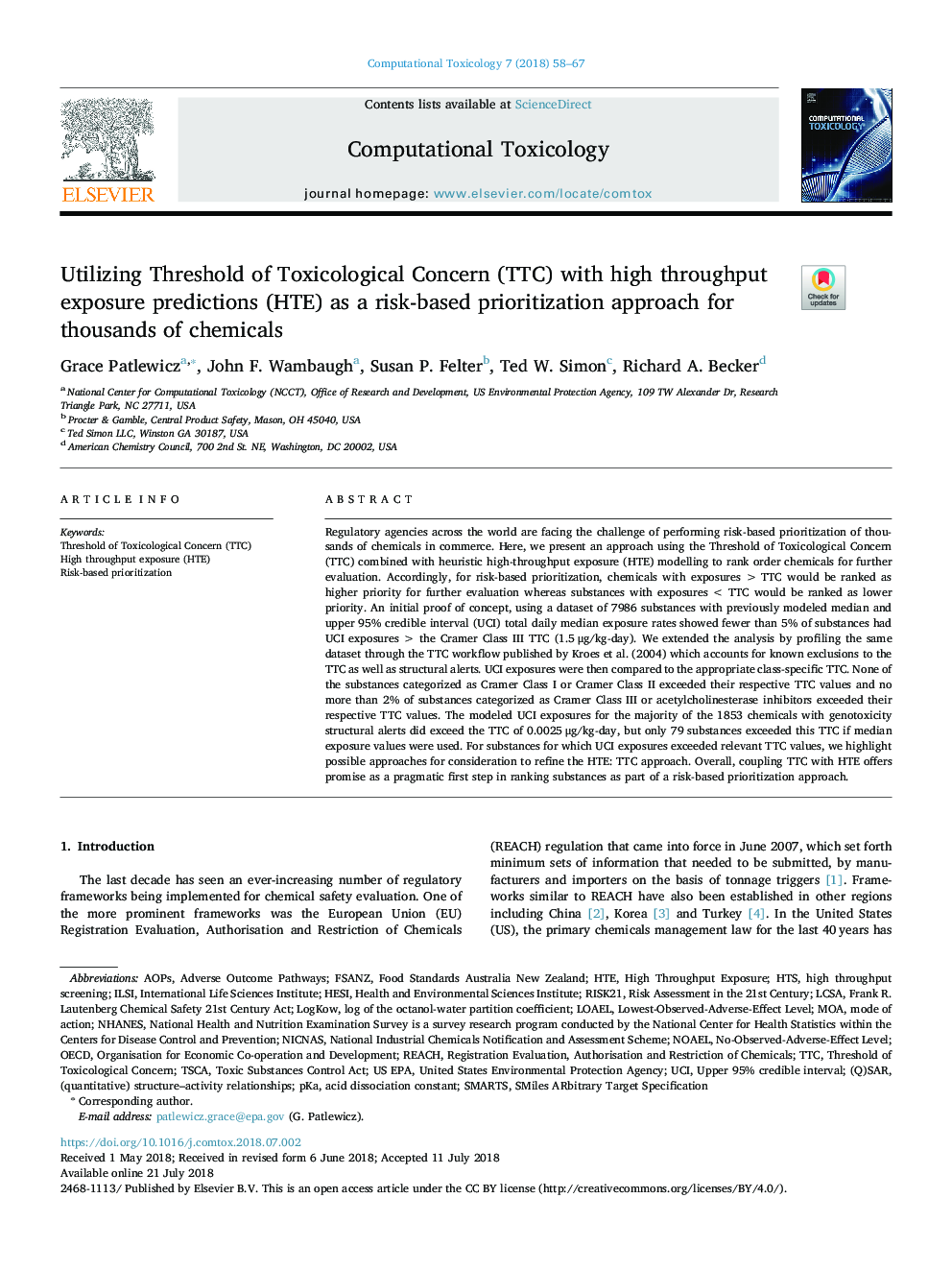| کد مقاله | کد نشریه | سال انتشار | مقاله انگلیسی | نسخه تمام متن |
|---|---|---|---|---|
| 8376699 | 1543159 | 2018 | 10 صفحه PDF | دانلود رایگان |
عنوان انگلیسی مقاله ISI
Utilizing Threshold of Toxicological Concern (TTC) with high throughput exposure predictions (HTE) as a risk-based prioritization approach for thousands of chemicals
دانلود مقاله + سفارش ترجمه
دانلود مقاله ISI انگلیسی
رایگان برای ایرانیان
کلمات کلیدی
LOAELLCSAlogKOWHTEThreshold of toxicological concern (TTC)TSCAILSINOAELHTSMOApKaOECDNHANESFood Standards Australia New ZealandFSANZTTCUCI(Q)SAR - (Q) SARAOPs - AOP هاUS EPA - EPA ایالات متحدهThreshold of toxicological concern - آستانه نگرانی سمیUnited States Environmental Protection Agency - آژانس حفاظت از محیط زیست ایالات متحدهacid dissociation constant - ثابت جداسازی اسیدMode of action - حالت عملREACH - رسیدنSMARTS - ساراOrganisation for Economic Co-operation and Development - سازمان همکاری اقتصادی و توسعهLowest-observed-adverse-effect level - سطح پایین ترین مشاهده شده - اثر ناخوشایندhigh throughput screening - غربالگری بالاToxic Substances Control Act - قانون کنترل مواد سمیInternational Life Sciences Institute - موسسه بین المللی علوم زندگیHealth and Environmental Sciences Institute - موسسه علوم بهداشت و محیط زیستHESI - ها Marchesino-observed-adverse-effect level - هیچ عارضه ای مشاهده نشدAdverse Outcome Pathways - پیامدهای ناخواسته
موضوعات مرتبط
مهندسی و علوم پایه
ریاضیات
ریاضیات محاسباتی
پیش نمایش صفحه اول مقاله

چکیده انگلیسی
Regulatory agencies across the world are facing the challenge of performing risk-based prioritization of thousands of chemicals in commerce. Here, we present an approach using the Threshold of Toxicological Concern (TTC) combined with heuristic high-throughput exposure (HTE) modelling to rank order chemicals for further evaluation. Accordingly, for risk-based prioritization, chemicals with exposuresâ¯>â¯TTC would be ranked as higher priority for further evaluation whereas substances with exposuresâ¯<â¯TTC would be ranked as lower priority. An initial proof of concept, using a dataset of 7986 substances with previously modeled median and upper 95% credible interval (UCI) total daily median exposure rates showed fewer than 5% of substances had UCI exposuresâ¯>â¯the Cramer Class III TTC (1.5â¯Î¼g/kg-day). We extended the analysis by profiling the same dataset through the TTC workflow published by Kroes et al. (2004) which accounts for known exclusions to the TTC as well as structural alerts. UCI exposures were then compared to the appropriate class-specific TTC. None of the substances categorized as Cramer Class I or Cramer Class II exceeded their respective TTC values and no more than 2% of substances categorized as Cramer Class III or acetylcholinesterase inhibitors exceeded their respective TTC values. The modeled UCI exposures for the majority of the 1853 chemicals with genotoxicity structural alerts did exceed the TTC of 0.0025â¯Î¼g/kg-day, but only 79 substances exceeded this TTC if median exposure values were used. For substances for which UCI exposures exceeded relevant TTC values, we highlight possible approaches for consideration to refine the HTE: TTC approach. Overall, coupling TTC with HTE offers promise as a pragmatic first step in ranking substances as part of a risk-based prioritization approach.
ناشر
Database: Elsevier - ScienceDirect (ساینس دایرکت)
Journal: Computational Toxicology - Volume 7, August 2018, Pages 58-67
Journal: Computational Toxicology - Volume 7, August 2018, Pages 58-67
نویسندگان
Grace Patlewicz, John F. Wambaugh, Susan P. Felter, Ted W. Simon, Richard A. Becker,